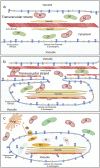Taro raphide-associated proteins: Allergens and crystal growth
- PMID: 36091877
- PMCID: PMC9440338
- DOI: 10.1002/pld3.443
Taro raphide-associated proteins: Allergens and crystal growth
Abstract
Calcium oxalate raphide crystals are found in bundles in intravacuolar membrane chambers of specialized idioblasts cells of most plant families. Aroid raphides are proposed to cause acridity in crops such as taro (Colocasia esculenta (L.) Schott). Acridity is irritation that causes itchiness and pain when raw/insufficiently cooked tissues are eaten. Since raphides do not always cause acridity and since acridity can be inactivated by cooking and/or protease treatment, it is possible that a toxin or allergen-like compound is associated with the crystals. Using two-dimensional (2D) gel electrophoresis and mass spectrometry (MS) peptide sequencing of selected peptides from purified raphides and taro apex transcriptome sequencing, we showed the presence on the raphides of peptides normally associated with mitochrondria (ATP synthase), chloroplasts (chaperonin ~60 kDa), cytoplasm (actin, profilin), and vacuole (V-type ATPase) that indicates a multistage biocrystallation process ending with possible invagination of the tonoplast and addition of mucilage that may be derived from the Golgi. Actin might play a crucial role in the generation of the needle-like raphides. One of the five raphide profilins genes was highly expressed in the apex and had a 17-amino acid insert that significantly increased that profilin's antigenic epitope peak. A second profilin had a 2-amino acid insert and also had a greater B-cell epitope prediction. Taro profilins showed 83% to 92% similarity to known characterized profilins. Further, commercial allergen test strips for hazelnuts, where profilin is a secondary allergen, have potential for screening in a taro germplasm to reduce acridity and during food processing to avoid overcooking.
Keywords: actin; biomineralization; calcium oxalate; crystalloplastids; profilin; transvacuolar strands.
© 2022 The Authors. Plant Direct published by American Society of Plant Biologists and the Society for Experimental Biology and John Wiley & Sons Ltd.
Conflict of interest statement
The authors declare no conflict of interest.
Figures







Similar articles
-
Systematic review on raphide morphotype calcium oxalate crystals in angiosperms.AoB Plants. 2023 Jun 6;15(4):plad031. doi: 10.1093/aobpla/plad031. eCollection 2023 Jul. AoB Plants. 2023. PMID: 37554287 Free PMC article. Review.
-
The synergistic effect of multiple organic macromolecules on the formation of calcium oxalate raphides of Musa spp.J Exp Bot. 2024 Apr 15;75(8):2470-2480. doi: 10.1093/jxb/erae022. J Exp Bot. 2024. PMID: 38243384
-
The acrid raphides in tuberous root of Pinellia ternata have lipophilic character and are specifically denatured by ginger extract.J Nat Med. 2020 Sep;74(4):722-731. doi: 10.1007/s11418-020-01425-6. Epub 2020 Jun 26. J Nat Med. 2020. PMID: 32591979 Free PMC article.
-
Cellular ultrastructure and crystal development in Amorphophallus (Araceae).Ann Bot. 2008 May;101(7):983-95. doi: 10.1093/aob/mcn022. Epub 2008 Feb 19. Ann Bot. 2008. PMID: 18285357 Free PMC article.
-
Profilins: mimickers of allergy or relevant allergens?Int Arch Allergy Immunol. 2011;155(3):191-204. doi: 10.1159/000321178. Epub 2011 Feb 2. Int Arch Allergy Immunol. 2011. PMID: 21293140 Review.
Cited by
-
Rapid detection of Tulipalin A with SESI-Orbitrap MS: an exploration across spring flowers.Plant Methods. 2025 Feb 5;21(1):14. doi: 10.1186/s13007-025-01331-6. Plant Methods. 2025. PMID: 39910633 Free PMC article.
References
-
- Akpan, E. J. , & Umoh, I. B. (2004). Effect of heat and tetracycline treatments of the food quality and acridity factors in cocoyam (Xanthosoma sagittifolium (l) Schott). Pakistan Journal of Nutrition, 3, 240–243.
LinkOut - more resources
Full Text Sources
Research Materials
Miscellaneous

